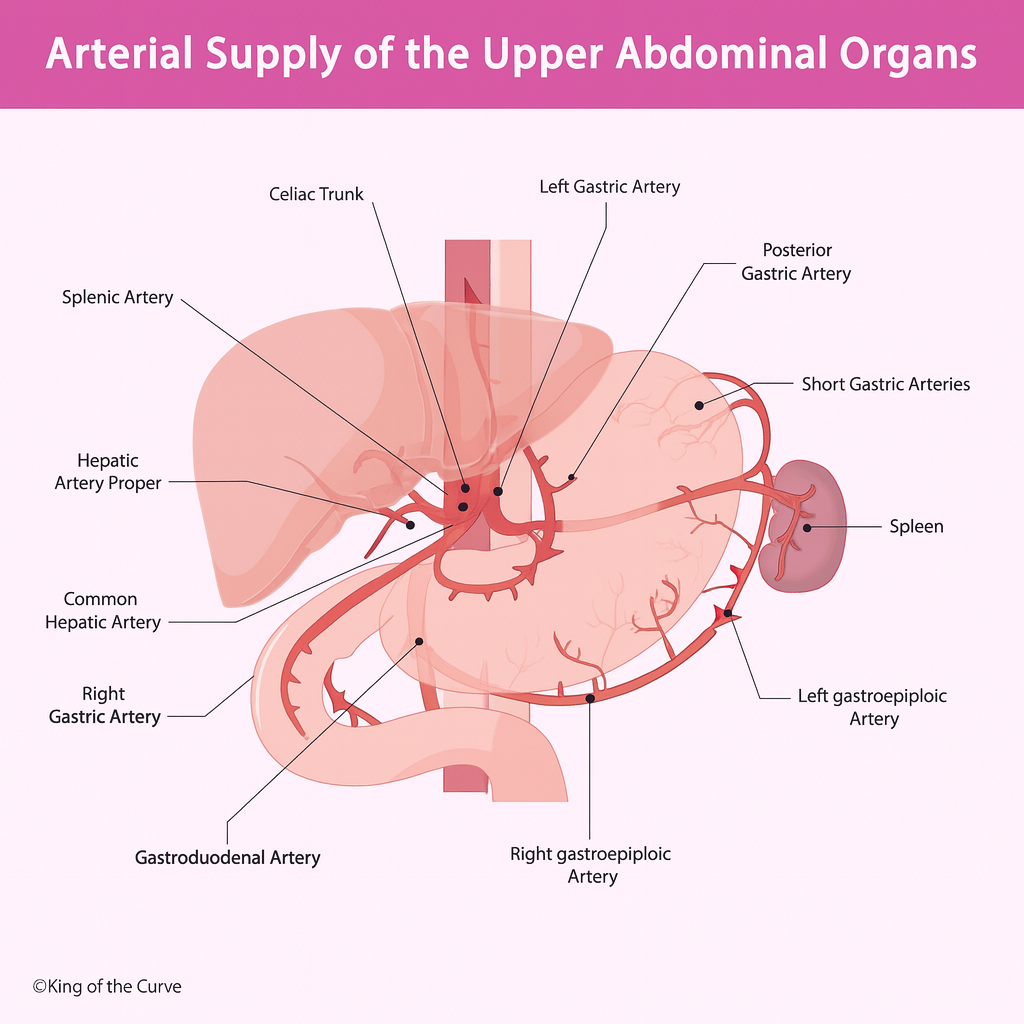🩺 Arterial Supply of the Upper Abdominal Organs: Anatomy Explained
The arterial supply of the upper abdominal organs is a complex network of blood vessels that ensures oxygen-rich blood reaches key digestive organs such as the stomach, liver, spleen, and parts of the pancreas. Understanding these arteries is vital for surgeons, radiologists, and medical students, as it forms the foundation for diagnosing vascular disorders and planning abdominal surgeries.
🔍 Overview of the Main Arteries
The celiac trunk is the primary artery that supplies the upper abdominal organs. It branches into three main arteries — the left gastric artery, the splenic artery, and the common hepatic artery — each of which further divides to serve specific regions.
Key Arteries and Their Functions
Celiac Trunk – The main arterial branch from the abdominal aorta supplying the foregut.
Left Gastric Artery – Supplies blood to the stomach and lower esophagus.
Splenic Artery – Supplies the spleen, pancreas, and part of the stomach.
Common Hepatic Artery – Divides into the hepatic artery proper (to the liver) and the gastroduodenal artery (to the stomach and duodenum).
Right Gastric Artery – Supplies the lesser curvature of the stomach.
Right and Left Gastroepiploic Arteries – Supply the greater curvature of the stomach.
Short Gastric Arteries – Supply the upper part of the stomach.
📊 Table: Branches of the Celiac Trunk and Their Supply Areas
| Artery | Origin | Supplies |
|---|---|---|
| Left Gastric Artery | Celiac Trunk | Stomach (lesser curvature), lower esophagus |
| Splenic Artery | Celiac Trunk | Spleen, pancreas, stomach |
| Common Hepatic Artery | Celiac Trunk | Liver, stomach, duodenum, pancreas |
| Hepatic Artery Proper | Common Hepatic Artery | Liver, gallbladder |
| Right Gastric Artery | Hepatic Artery Proper | Stomach (lesser curvature) |
| Gastroduodenal Artery | Common Hepatic Artery | Stomach, duodenum, pancreas |
| Right Gastroepiploic Artery | Gastroduodenal Artery | Stomach (greater curvature) |
| Left Gastroepiploic Artery | Splenic Artery | Stomach (greater curvature) |
| Short Gastric Arteries | Splenic Artery | Stomach (fundus) |
🧠 Clinical Importance
Surgical Relevance: Knowledge of these arteries is critical in procedures like partial gastrectomy, liver transplantation, and splenectomy.
Radiological Diagnosis: Imaging studies such as CT angiography depend on accurate mapping of these vessels.
Pathology: Arterial blockages can lead to ischemia of stomach, liver, or spleen tissues, which can be life-threatening.
📌 Summary
The celiac trunk and its branches form a lifeline for the upper abdominal organs. A deep understanding of their course and supply regions aids not only in academic learning but also in real-life clinical decision-making.
🚀 Call to Action
If you found this breakdown helpful, make sure to share it with your fellow medical learners and bookmark it for quick revision before exams or surgical rotations. For more in-depth anatomy guides and clinical correlations, explore our full collection of King of the Curve anatomy resources.
Frequently Asked Questions (FAQs)
-
Aim for 4-6 focused hours, ensuring you incorporate breaks to avoid burnout.
-
Practice mindfulness techniques, take practice exams under realistic conditions, and maintain a balanced lifestyle.
-
Set short-term goals, seek support from mentors, and reward yourself for small achievements.
-
Regular exercise improves focus, reduces stress, and enhances overall mental clarity.
-
KOTC offers personalized learning tools, gamification features, and adaptive question banks to help students stay on track without burnout.


